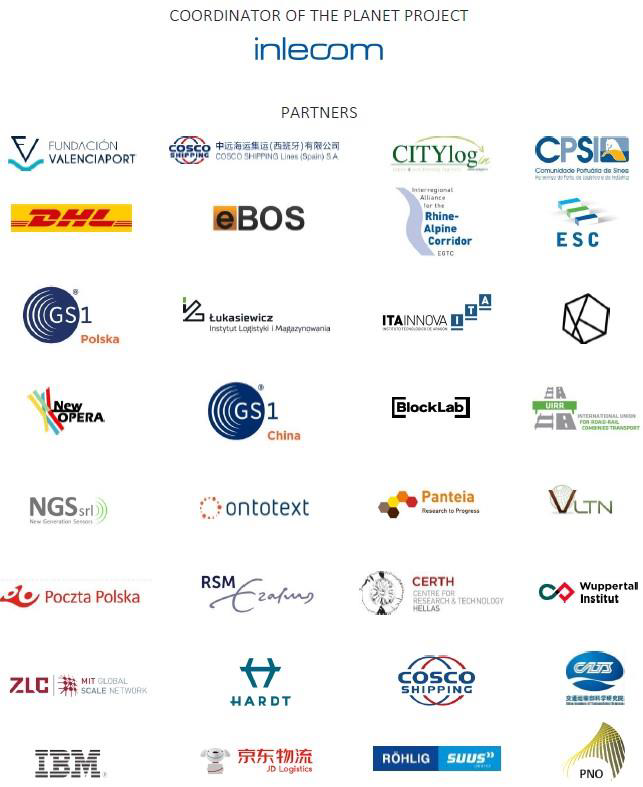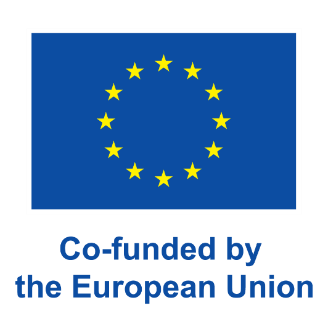
The Trans-European Transport Network (TEN-T) consists of hundreds of projects aimed at ensuring cohesion, interconnection and interoperability of all modes of transport across the EU. With TEN-T projects located in every EU member state, numerous challenges are associated with assessing the impact of emerging global trade corridors on the TEN-Ts. The EU-funded PLANET project will address this issue by demonstrating the emerging concepts of the physical internet and technologies such as the Internet of Things and blockchain in three EU–global real-world corridors (China–EU–US). The project will model, analyse, demonstrate and assess EU–global T&L networks (EGTN). It will deliver a symbiotic digital clone for EGTNs as well as an active blueprint and roadmap towards their realisation.
PLANET is a project co-funded by the Horizon 2020 Program of the European Commission, starting on the 1st of June 2020, that goes beyond strategic transport studies and ICT for transport research, by demonstrating the emerging concepts (Physical Internet) and technologies (IoT, Blockchain) in three EU-global real-world corridors (China – EU- US). The project, which is scheduled to last 36 months, will focus in two key R&D pillars:
- A Geo-economics approach, modelling and specifying the dynamics of new trade routes and their impacts on logistics infrastructure and operations, with specific reference to TEN-T;
- An EU-Global network enablement through demonstration of disruptive concepts and technologies (IoT, Blockchain and PI, 5G, 3D printing, autonomous vehicles /automation, hyperloop) which can shape its future and address its shortcomings.
Three Living Labs will contribute to the strategic analysis of global flows, the analysis of corridor infrastructure issues, and the investigation of integration of the respective global corridor with the TEN-T. Furthermore, all Living Labs will investigate innovative ways to coordinate complex supply chains through multimodal corridors involving private and public stakeholders.
List and short description of relevant pilots/living labs or test beds:
Living Lab 1: Physical Internet and Blockchain for optimised door-to-door Asia-Europe corridors – Mediterranean Corridor
LL1 will evaluate how new technologies (IoT, AI and blockchain) and concepts (Physical Internet) can improve processes, operations and efficiency along the door-to-door transport chains linking the Maritime Silk Road with EU internal corridors. LL1 will be divided in to two main use cases:
- The first use case will focus on import/export door-to-door transport chain of containerized cargo between China and Spain and will evaluate how the combination of IoT (for real-time monitoring of logistics assets), AI (for better forecasts and intelligent decisions based on machine learning algorithms) and blockchain (for paperless transactions and the register of transport events), can contribute to a better management of the transport chain. The development of the PI paradigm will be investigated, where intelligent logistic nodes or hubs play a key role in transport decisions and are optimized based on real time events/information and historical data.
- The second use case will focus on warehouse operations and will explore how new IoT, AI, AR and automation technologies can contribute to the development of intelligent automated logistics nodes of the EGTN/PI network. This use case will complement Use Case 1, particularly on how to integrate smart Warehouse Nodes for EGTN routing decisions, ultimately creating PI Warehousing Nodes. The extended level of potential automation will be represented through simulation.
Living Lab 2: Synchromodal dynamic management of TEN-T and intercontinental flows promoting rail transport
LL2 will focus on dynamic and Synchromodal management of TEN-T & intercontinental flows promoting rail transport and utilising the Port of Rotterdam as the principal smart EGTN Node coordinating the rail focused transport chains linking China through Rotterdam to/from USA, and the Rhine-Alpine Corridor destinations. LL2 will include 3 main use cases:
- The first use case will focus on Synchromodality in a Blockchain enabled Platform utilising advanced IoT, supporting PoR customers & communities to create the best multi-modal alternatives for logistics solutions within the LL2 corridors43.
- The second use case will focus on investigating Eurasian rail freight expansion in the LL2 corridor. LL2 will also utilize use case 1 tools to investigate freight flow synergies and Blockchain innovation to support integration with European RFCs.
- The third use case will analyse LL2 corridor flows and assess the implication for Port of Rotterdam and TEN-T infrastructure, extending results with data from EGTC and use cases 1 and 2. The use of the PLANET tools by Port of Rotterdam and “Interregional Alliance for the Rhine-Alpine Corridor EGTC’’ is directed at strategic corridor planning and in use by EGTC members in the context of use case1.
Living Lab 3: IoT for Silk Road Route – reliable, transparent and fully connected corridor from China to the EU
LL3 will focus on streamlining logistic processes in flows from China to Europe along the Silk Road by implementing IoT technologies (based on the EPCIS platform) and GS1 standards that facilitate transmission of data between the partners involved in the e-commerce operations. LL3 aims at:
Standardising information flows and digitalising interactions between actors within the network (Alibaba, China Post, Polish National Post);
- Providing access to real time information on cargo coming from China to Poland along the entire supply chain through application of IoT and EPCIS to monitor supply chain events and support operational optimisation;
- Facilitating effective co-modal end-to end transport within EU’s internal rail network.
Key Exploitable Results
PLANET has worked on 9 key exploitable results listed below. Only public ones are available, if you want more information on any of them, contact Jeanett Bolther from PNO who is in charge of PLANET exploitation.
- PLANET KERs – KER1 Volume flow forecasting service for warehouses
- PLANET KERs – KER2 Hyperloop
- PLANET KERs – KER3 Intelligent Decision Support Algorithm for JIT rail shuttle service
- PLANET KERs – KER4 Track & Trace Monitoring Services
- PLANET KERs – KER5 End-to-End Digital and Document Management
- PLANET KERs – KER6 New distributed ledger technology for smart contract blockchain interop
- PLANET KERs – KER7 Logistics Single Window Platform
- PLANET KERs – KER8 PI routing Algorithms
- PLANET KERs – KER9 Smart and Collaborative Platform
White papers published
- PLANET_WHITE PAPER_AI-Based Freight Volume Forecasting.
- PLANET_WHITE PAPER_Decentralised management of logistics documentation
- PLANET_WHITE PAPER_PLANET TEN-T Revision
- PLANET_WHITE PAPER_System For Global Transportation Tracking
Deliverables published
- PLANET_D1.1 EGTN Foundational Position Papers and Simulation Scenarios
- PLANET_D1.3 Modelling & Simulation Capability final version
- PLANET_D1.5 Simulation based impact of new trade routes on TEN T and disadvantaged regions final version
- PLANET_D1.7 Legislation EU Policy to impact EGTN final version
- PLANET_D1.9 Simulation-based analysis of T&L and ICT innovation technologies final version
- PLANET_D1.10 EGTN Reference Specification v1
- PLANET_D2.2 Open EGTN Platform Architecture Final Version
- PLANET_D2.8 EGTN Transport Data and Knowledge models final version
- PLANET_D2.9 EGTN Support Services based on Big Data analytics models
- PLANET_D2.12 Multi-Actor Multi-Criteria Analysis final version
- PLANET_D2.14 Intelligent PI Nodes and PI Network services final version
- PLANET_D2.16 Integration and Interoperability of proprietary Blockchain Systems for Seamless Global Trade Workflows final version
- PLANET_D2.18 EGTN smart contracts and associated PI motivated workflows in the context of SLA management final version
- PLANET_D3.1 LL1 Specifications and baseline measurements
- PLANET_D3.3 LL2 Specifications and baseline measurements
- PLANET_D3.5 LL3 Specifications and baseline measurements
- PLANET_D3.7 EGTN Generic Use Case v.1
- PLANET_D4.1 Recommendations for TEN-T interfacing to Global Trade Routes
- PLANET_D4.2 Policy guide, Briefing sheets and case study on freight transport for policymakers in emerging economies
- PLANET_D5.1 Stakeholder Analysis Report
- PLANET_D5.2 Observations and Recommendations of the Advisory Board v1
Living labs
- PLANET Living Lab 1 PI and Blockchain for optimised door-to-door Asia-Europe Corridors – Mediterranean Corridor
- PLANET Living Lab 2 Synchromodal dynamic management of TEN-T & intercontinental flows promoting rail transport
- PLANET Living Lab 3 IoT for Silk Road Route: reliable, transparent and fully connected corridor China-EU
Work packages
- WP1 EU-Global T&L Networks [EGTN]
- WP2 Cloud-based Open EGTN Infrastructure
- WP3 Living Labs
- WP4 Steering innovation & building capacity towards EGTN
- WP5 Dissemination Commercialisation Policy recommendations
PLANET annual summary reports
Have a look to these annual reports to get insights on the main project developments and evolution.
Communication materials for download
- PLANET Project Brochure_FV
- PLANET_SM FACTSHEET_FV
- 1_PLANET_Newsletter
- 2_PLANET_Newsletter
- 3_PLANET_Newsletter
- 4_PLANET_Newsletter
- 5_PLANET_Newsletter
- 6_PLANET_Newsletter
- 7_PLANET_Newsletter
- 8_PLANET_Newsletter
- 9_PLANET_Newsletter
- EGTN_PLANET_SM FACTSHEET
For more information click here to visit PLANET website
If you have any question or want to connect with PLANET click here to visit ALICE Knowledge Platform PLANET page
PLANET partnership
The project has 40 partners from all over Europe, representing the entire heavy-duty value chain. It includes ALICE members: CERTH/HIT, CPLS, ESC, inlecom, ITAINNOVA, New OPERA, Lukasiewicz ILM, PNO, UIRR, Valenciaport, ZLC
Related events
Related news


